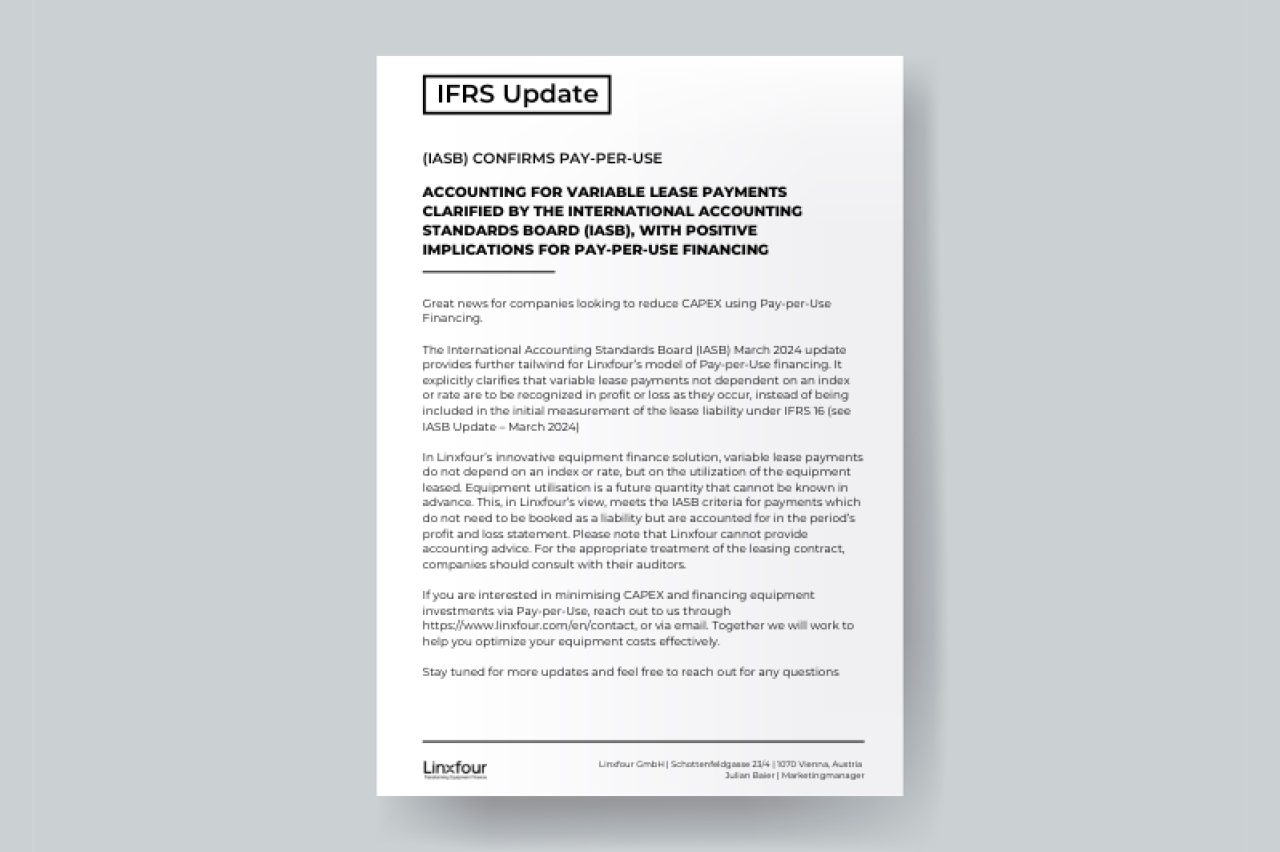Accounting for variable lease payments clarified by the International Accounting Standards Board (IASB), with positive implications for Pay-per-Use Financing
Great news for companies looking to reduce CAPEX using Pay-per-Use Financing.
The International Accounting Standard Board’s (IASB) March 2024 update provides further tailwind for Linxfour’s model of Pay-per-Use financing. At Linxfour, we are excited to bring more attention to this update and highlight how it aligns with our financing solutions, providing equipment operators clarity on the accounting treatment of variable lease payments.
The Core Update
The IFRS 16 standard, introduced in 2016, was a significant shift for lessees, requiring almost all leases to be recognised on their balance sheet. However, the treatment of variable lease payments, particularly those that are not dependent on an index or rate, has been a topic of ongoing discussion and uncertainty. The IASB update in March 2024 has provided further clarity in this regard, confirming that variable lease payments not dependent on an index or rate are to be recognised in profit or loss as they occur instead of being included in the initial measurement of the lease liability.
This is a crucial distinction. Historically, variable lease payments that were not included in the initial measurement of lease liabilities created accounting uncertainty for businesses. The IASB clarification acknowledges that payments purely based on asset usage fall outside the scope of liabilities that need to be capitalised, resulting in an off-balance-sheet treatment of these costs.
The Pay-per-Use Model: Aligned with IASB Guidelines
Linxfour’s Pay-per-Use financing model was designed with flexibility and operational efficiency in mind. Unlike traditional lease arrangements, with predominantly fixed payments, Pay-per-Use adjusts lease payments based on actual utilisation of the equipment. As confirmed by the recent IASB update, variable payments – tied directly to usage – are not dependent on indices or rates. Equipment utilisation is a future quantity that cannot be known in advance. This, in Linxfour’s view, meets the IASB criteria for payments that do not need to be booked as a liability but are accounted for in the period’s profit and loss statement.
For equipment operators, this means that instead of recognising these costs upfront as a liability, they are accounted for in profit and loss as they occur. This can provide substantial benefits, particularly in terms of maintaining a lean balance sheet and optimising key financial metrics.
Practical Implications
The shift towards recognising usage-based payments in profit or loss can have several significant impacts on financial reporting and decision-making:
Improved Financial Metrics: With variable lease payments no longer recognised as a lease liability, businesses can maintain lower reported liabilities, positively impacting key ratios like debt-to-equity and return on assets.
Greater Cash Flow Flexibility: The alignment of lease expenses with equipment utilisation enables better cash flow management, especially for businesses with fluctuating operational demands.
Enhanced Strategic Planning: By avoiding the capitalisation of usage-based payments, companies have more room to manoeuvre when planning long-term investments and financing strategies.
Addressing Concerns and Ensuring Compliance
While this update provides significant benefits, it’s important for businesses to engage with their accounting teams or advisors to ensure that they’re fully aligned with these changes. Please note that Linxfour cannot provide accounting advice. The correct classification and reporting of lease payments are essential for compliance under IFRS 16. We recommend referencing the official IASB communication for full details and working closely with your financial stakeholders to seamlessly integrate these guidelines into your accounting practices.
Talk to Us
Are you interested in reducing CAPEX and financing equipment with Pay-per-Use, then contact us through https://www.linxfour.com/en/contact. Together, we will help you optimise equipment costs effectively!
*Please note that this is not an accounting advice from Linxfour. Please consult with your auditor as to the appropriate treatment of the leasing contract in your accounts.
Source: IASB Update – March 2024 https://www.ifrs.org/content/dam/ifrs/publications/pdf-standards/english/2024/issued/part-a/ifrs-16-leases.pdf?bypass=on


